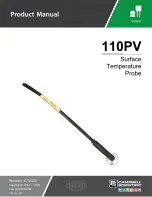
98
VAV-SVP01A-EN
Troubleshooting
Duct Temperature Sensor Failure Procedures
In the event that the VV550 reports an incorrect or failed Discharge or Primary air temperature,
properly inspect the following:
1.
Make sure VAV VV550 has been configured for the input
2. Discharge or Primary air temperature is higher or lower than what the VV550 reads
•
Check the location and installation of the sensor. Change the calibration factor in the VV550
setup screens.
Note:
If sensor is off more than ± 2 degrees continue to number 3.
3. Auxiliary sensor wired incorrectly
•
Check wiring for the correct connections. See Chapter 2 for further details on Discharge or
Primary air sensor wiring.
4. Defective sensor
•
Disconnect the sensor terminal plug from the VV550 and using an Ohmmeter, measure the
resistance across the auxiliary sensor wires. Compare the resistance to temperature using
Table 11, p. 72
. The resistance measured should correspond to a temperature within ± 2
degrees near those measured with an accurate temperature measuring device. If not, the
sensor needs to be replaced.
5. Defective wiring or VV550
•
See if the VAV VV550 Controller is outputting 5VDC. This can be done by disconnecting the
wires on the VAV VV550 Controller on terminals TB3-5 and TB3-6 for Discharge air
temperature sensor or for supply air temperature sensor and measure the VDC. It should be
5VDC. If you have 5VDC at the VV550 the wires going to the auxiliary sensor have an open.
If 5VDC is not present check incoming power to the VV550 board on TB1-1 24VAC input and
TB1-2. Voltage should measure 24VAC ± 10%. If you measure the proper voltage at TB1-1
24VAC input and TB1-2 and no voltage at TB3-5 and TB3-6 for Discharge air temperature
sensor or TB3-5 and TB3-6 for Supply air temperature sensor. Replace the VV550.
VAV Damper Failure Procedures
WARNING
Hazardous Service Procedures!
The maintenance and troubleshooting procedures recommended in this section of the manual
could result in exposure to electrical, mechanical or other potential safety hazards. When
possible, disconnect all electrical power including remote disconnect and discharge all energy
storing devices such as capacitors before servicing. Follow proper lockout/tagout procedures to
ensure the power can not be inadvertently energized. When necessary to work with live
electrical components, have a qualified licensed electrician or other individual who has been
trained in handling live electrical components perform these tasks. Failure to follow all of the
recommended safety warnings provided, could result in death or serious injury.
In the event that the air valve is not modulating, properly inspect the following:
1.
Tracer Summit or Rover service tool has enabled an override function in VAV VV550
•
The overrides are Open, Closed, Min, or Max. Disable all overrides.
Note:
See VV550 programming and operation chapter to be able to release override with Rover
service tool
•
VV550 is going through a recalibrate (reset) command. This is shown in the diagnostic log
in Rover service tool
•
Wait for calibration to finish.
2. Zone temperature is greater than the heat set point or less than the cool set point
Summary of Contents for VAV VV550 LonTalk
Page 1: ...May 2010 VAV SVP01A EN Installation Operation Programming VAV VV550 LonTalk Controller...
Page 17: ...VAV SVP01A EN 17 VAV Start Up Check Out Procedure Figure 2 VV550 single duct control diagram...
Page 18: ...18 VAV SVP01A EN VAV Start Up Check Out Procedure Figure 3 VV550 fan powered control diagram...
Page 107: ...VAV SVP01A EN 107 Troubleshooting Figure 59 VV550 single duct control diagram...
Page 108: ...108 VAV SVP01A EN Troubleshooting Figure 60 VV550 fan powered control diagram...
Page 110: ...110 VAV SVP01A EN Troubleshooting Figure 62 Single duct with three phase voltage electric heat...
Page 115: ......
















































